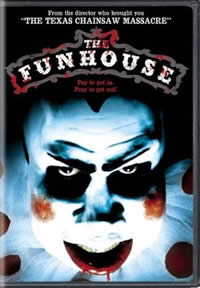Zombos Says: Very Good
Director Tobe Hooper, who did the unsettling Dance of the Dead episode for Masters of Horror on Showtime, as well as the family classic, Texas Chainsaw Massacre (1974)—insane family, that is—presents a not so pretty picture of carnival life, and a somewhat pathetic, definitely homicidal, disfigured monster with a penchant for temper tantrums.
The opening of the movie is a nod to Halloween and Psycho, and from there builds into a creepy story revolving around teen lust, sleazy carnival characters, and a ‘man-made monster that has needs like everyone else, but simply cannot satisfy them in more socially acceptable ways. A fascinating subtext running through the story is that it is a variation on the tragedy of Dr. Frankenstein and his monster. Here, the monster is one born of genetic mutation, as foreshadowed by the Freak Animals Alive tent exhibit, where the fetal brother of the monster floats in a jar as an abominable attraction for the hoi polloi.
In the movie’s opening sequence, the Frankenstein Monster is shown, first as a poster showing the Glenn Strange characterization (my favorite!), and then as a Mego doll—oh sorry, action figure—carried by the young Joey, whose sister soon curses him because of his bizarre prank that scares the wits out of her. Joey’s actions are also another subtext running through the movie: he dons a mask to become a monster that frightens his sister, and the actual monster wears a Frankenstein Monster mask to become less frightening to others.
It’s interesting to note that, unlike the current spate of horror movies that feature eye (popping)-candy and little else, in this movie the characters are presented with choices, yet consistently make the wrong ones. And as we all know, in a horror movie when you make the wrong choices someone—or more likely everyone—winds up dead.
Amy, Buzz, Liz, Ritchie, and Joey consistently make the wrong choices, and suffer the dire consequences. In the tale of Dr. Frankenstein and his monstrous creation, wrong choices led to death and disaster; at least here we have the funhouse; iconic abode for numerous urban legends and rustic tales told over and over again around camp fires and sleep-over parties.
The funhouse is surrounded by the carnival, a seedy, grimy affair filled with seedy and grimy denizens. There is a bag lady that looks very much like Grandmama from the Addams Family spouting “god is watching you!;” a homeless man that wanders around like a zombie from Night of the Living Dead; a few bums; the past-her-prime fortuneteller and palm reader (Sylvia Miles); and the not so magnificent Marco the Magician and the carny barkers (three of them played by Kevin Conway as if he were a natural).
Properly toned by John Beal’s score and Andrew Lazlo’s moody cinematography, the loud and brightly lit carnival facade hides a darker, more primitive underbelly of murderous anarchy, repressed emotions, and dark secrets, with the funhouse as its nexus. Hooper’s use of two tracking crane shots, one at the beginning and one at the ending of the mayhem, emphasize this emanation of evil flowing first toward the funhouse, and then outwardly from it.
Our hapless group of victim fodder soon regrets their decision to stay the night in the funhouse, and Joey soon regrets sneaking out from his bedroom—down the trusty-trellis-by-the-window to visit the carnival. We also learn that the father of the monster has regrets about letting it live, in a scene that contains a wealth of hinted at backstory. Because of his decision he must share responsibility for its murderous actions, just like Dr. Frankenstein must share responsibility for his Monster’s subsequent actions.
Priming the coming mayhem, the fun-seeking and frisky teens decide to spend a night in the funhouse after closing time, and after the requisite fun-that-must-be punished-for scenes, they witness a murder, and promptly wind up stepping deeper and deeper into a big pile of no return. One of them makes another spur-of-the-moment bad decision, letting the wrong people learn about their presence in the locked funhouse. Scenes of carnage follow as one by one the teens meet their untimely and grisly death in 1980s horror fashion.
A particularly harrowing moment has our heroine calling to her parents through a large, wildly-spinning exhaust fan, but of course they can’t hear her because she is too far away—in the funhouse, where they specifically told her not to go. But they aren’t there for her; they are looking for their errant son Joey, who also disobeyed them. People who disobey or don’t listen or don’t read signs well in horror movies suffer dire consequences for their actions, and little Joey is no exception. His parents meet the shady and perhaps too-interested carnival handyman that found Joey sneaking around the tents. His actions are never quite clear, and Joey is strangely out of it so we never really know what happened between him and the handyman, but whatever it is it's hinting at unsavory.
The climactic confrontation in the mechanical belly of the funhouse is suitably horrific yet uses little gore, and unlike the requisite sequelization-antics of many fright movies today provides a definitive and satisfying closure.
Unlike the simplistic snuff-horror by the numbers approach in today’s movies, The Funhouse explores dark themes and provides a story depth that is worth experiencing, along with the thrills and chills.




I remember this movie from when I was young. I remember it freaking me out, but that was rather easy when I was young. Got me curious what a more mature...well, older me would think.
Posted by: kanrei | August 24, 2006 at 09:04 PM